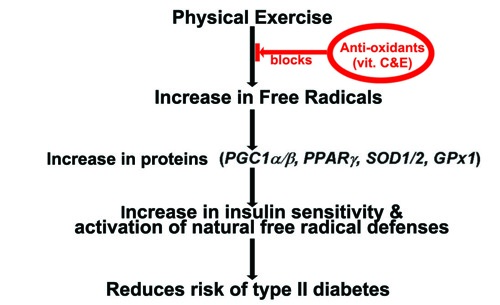We all know exercise is good for you. If you have type II diabetes, exercise helps with insulin resistance — so much so that exercise seems to be better than metformin (the most used anti-diabetic drug).
But I have a question – why is exercise good for you?
Stress can be good for you
Most people forget that exercise is stress. I’m sure all of you who exercise regularly are well aware that exercise is stressful — at least it should be if you‘re doing it right.
I’m not talking about “you’ve been stuck in traffic for the last 3 hours on the way home from work” stressful or “watching your savings disappear in the stock market” stressful. (Sorry if I’m stressing you out by mentioning it.)
No, I’m talking about the type of stress that makes you feel better afterward — it could take a while but eventually, you feel better.
Let’s say you have a real good (aka hard) leg workout: squats, lunges and even some deadlifting. Then you try to walk down the stairs to the change room. If your workout was stressful enough, then walking down the stairs is a lot more challenging then you remember. Maybe the next day you waddle around like a penguin because your legs are sore and stiff.
Why? Because you have stressed your body and now it’s trying to recover and overcompensate.
Overcompensation is the whole basis of exercise. You body overcompensates after stress so it can handle the stress/exercise next time you go to the gym. If you work out and don’t push yourself, then you haven’t stressed your body enough so your body doesn’t need to overcompensate.
Why do I bring up the importance of stress? Because it explains why this week’s study found what it found. When you read this review, think about how stress (or response to stress) is changed because of the intervention.
Exercise and oxidative stress
Our cells continually produce free radicals, aka reactive oxygen species (ROS) as part of their normal day-to-day processes.(1) Think of it as the body’s natural “rusting” process. Free radicals cause damage in muscle as well as other tissues. The presence of higher numbers of free radicals is an indication of damage and is considered “bad”.
Normally we have a good antioxidant system for taking care of these — a regular polish with a little biological Rustoleum, so to speak. But when we exercise, we speed up certain processes, and we produce more free radicals. The body can’t keep up right away.
So the question is: would taking extra antioxidants help us recover better from the stress of exercise?
The role of vitamins C and E
In case you want to know the details, our natural system of antioxidants includes catalase, superoxide dismutase, glutathione peroxidase, and numerous non-enzymatic antioxidants, including glutathione, ubiquinone, flavonoids… and the more familiar vitamin C and E.
Vitamins C and E have actually been studied for their effects on exercise performance since the 1970s. But the results have been kind of puzzling. Sometimes it seems as though vitamin C and E are helpful, sometimes not.(2)
Hope springs eternal, so the researchers are still working on it.
Research question
This week I review a study on antioxidants and how they prevent exercise benefits like increased insulin sensitivity. (Okay, I gave away the ending, but you were going to read the title of the study weren’t you? But you still want to know what antioxidants, what type of exercise and why they don’t play nice.)
Ristow M, et al. Antioxidants prevent health-promoting effects of physical exercise in humans. Proc Natl Acad Sci U S A. 2009 May 11. [Epub ahead of print]
Methods
There were really two studies in one:
- An open label study (the participants and researchers knew who was getting the vitamins and who wasn’t)
- A double blinded placebo controlled study (neither the participants nor the researchers knew who was getting the vitamins)
Both studies were the same, with the exception of who knew what, with 28 days of vitamin (C and E) supplementation and exercise. Since the two studies were the same, the researchers combined the results from the two into one bigger study.
Participants
- 20 untrained young men
- 8 from the “open labelled study”
- 12 from the “double blind study”
- 20 untrained young men
- 8 from the “open labelled study”
- 12 from the “double blind study”
They ranged in age from 25-35 and on average they had a BMI of less than 27. And they were pretty healthy:
- No acute or chronic inflammatory disease
- No metabolic disease (including diabetes)
- No history of high blood pressure
- No cardiovascular, peripheral artery, thyroid disease
- No medications, alcohol, nicotine or drug use
Here’s one problem: Although this study looked at insulin sensitivity and has been interpreted with type II diabetics in mind, no participant actually had type II diabetes, pre-diabetes or type I diabetes.
That’s right — even though this study no doubt will be used for supplementation recommendations during exercise for diabetics, there are no diabetics in the study.
I point this out because often a study that examines one group gets applied to another group. For example, results from a study that used a group of healthy, young men gets interpreted for unhealthy, much older, people. Or studies done on older obese women get applied to fit young men. Studies of subjects with a particular disease are applied to healthy people. And so forth.
Guess what, this is pretty obvious: healthy is different than unhealthy — by definition — and so assuming everything will be the same in the two groups is crazy.
“Trained”
How did the researchers decide who was trained and who was untrained? Pretty simply: they asked the participants how much physical activity they did a week.
If a participant said he did more than 6 hours per week he was “trained”. If he said he did less than 2 hours per week, he was considered “untrained”. (No word on what happened with the people doing 2.1 – 5.9 hours per week… “undecided”?)
The trained group had a higher VO2 max (the body’s maximal ability to use oxygen) and more lean body mass (aka fat free mass). This isn’t a surprise, but it’s always good to find data that supports generally accepted ideas. Researchers didn’t look at body fat, so no comparisons between trained and untrained could be made.
Vitamins
The vitamin group (aka antioxidant group) were given 500 mg of vitamin C (specifically, ascorbic acid) twice a day and 400 IU of vitamin E (specifically, RRR-/D-a-tocopherol) once a day. This is a total of 1000 mg of vitamin C and 400 IU of vitamin E per day, which is well above the recommended amounts of 60 mg of vitamin C and 40 IU of vitamin E by Health Canada (a fairly standard recommendation worldwide).
What was the exercise?
One of my biggest peeves with how exercise studies is how they’re reported — especially ones not in exercise focused journals. They’re studies that don’t give much details about the “exercise”. The term “physical exercise” covers a lot: weight training exercise, running exercise, stretching exercise, etc.
Researchers reported what was done in this study, but almost as an afterthought with little detail. The exercise training reported involved 20 minutes of biking or running, 45 minutes of circuit training, and 20 minutes of warming up and cooling down (85 minutes total – 5 consecutive days/week for 4 weeks). No mention of intensity, type of circuit training or type of warm up or cool down. I’m assuming the circuit is some sort of weight training circuit, but that is unclear.
Results
Exercise causes increases in oxidative stress in muscle
Researchers looked at the participants’ muscle to compare before and after three days of exercise. The specifics aren’t necessary but if you want to know, the researchers measured oxidative stress using TBARS (thiobarbituric acid-reactive substances). The higher the TBARS the more reactive oxygen species (free radicals).
After three consecutive days of exercise with no supplementation, free radicals in muscle more than doubled. But after three consecutive days of exercise plus supplementation of vitamin C and E, free radicals didn’t increase at all!
This is pretty interesting and makes sense since vitamin C and E are antioxidants, which means they block chemical reactions (aka oxidation) by the free radicals that cause tissue damage.
Anybody taking vitamin C and E (either in food or in capsule) should be happy. The whole reason to take anti-oxidants like vitamin E and C is to stop free radical damage. And this study confirms this theory, but with a catch.
Too much of a good thing? Antioxidants prevent exercise induced increases in insulin sensitivity
Using a specific tests, glucose infusion rate (GIR) and adiponectin (a protein from fat that increases insulin sensitivity), the researchers could figure out how sensitive the participants were to insulin. The higher the GIR and adiponectin, the higher the insulin sensitivity.
In this study they found that untrained and pre-trained participants without supplementation had better insulin sensitivity after 4 weeks of exercise. No shocker there. Exercise has been found to increase insulin sensitivity, as measured by GIR and adiponectin. This is why exercise is improves type II diabetes, which is caused by insulin insensitivity.
But here is the surprise. The untrained and pre-trained participants taking vitamin C and E had no change in insulin sensitivity after 4 weeks of exercise.
In other words, exercise without extra anti-oxidants improved insulin sensitivity, but exercise with extra anti-oxidants did nothing for insulin sensitivity. No difference between the trained and untrained participants.
How can this be?
Well, the researchers looked at other proteins that are believed to trigger insulin sensitivity. Your body uses specific proteins to tell your body how to respond to different stresses. It’s like the telephone game you played in elementary school, but somewhat more accurate (thankfully, otherwise our body might be told “meat cart needle” instead of “keep heart beating”).
Different proteins trigger different responses. If there’s no change in protein, then there’s no response. Specific proteins (PGC-1a, PCG1-b, SOD1, SOD2 and GPx1) tell your body to increase insulin sensitivity. If they aren’t there, for whatever reason, your body doesn’t increase insulin sensitivity.
Normal exercise increases all of these proteins. However, in people taking vitamin C and E supplements, it didn’t. Without a change in these “signalling” proteins there is no change in insulin sensitivity.
Conclusion
Vitamin C and E supplementation prevent free radical accumulation after exercise, which is probably why there is no increase in insulin sensitivity.
Figure 1 is a summary of the chain of events that normally happens. As you can see, the presence of antioxidants (in red) blocks these events almost at the outset. Thus, by blocking the natural sequence of stress-response, antioxidants effectively prevent many of the good outcomes of exercise.
Bottom line
Before you stop eating oranges and almonds (a source of vitamin E) I’ll mention a few things.
First, the amount of vitamin C used in this study is 20 times the recommended amount. And the amount of vitamin E is 10 times what is recommended. This isn’t to say that “recommended” is perfect but it does put things in perspective. So in this study there is a lot of vitamin C & E. This means that normal intake will probably not mess up your exercise program.
However, if you supplement excessively, and you’re concerned about insulin sensitivity, I’d suggest reconsidering those pills. Based on this study, if you are a type II diabetic, pre-diabetic or have a high risk of diabetes I’d recommend that you don’t supplement with vitamin C and E before you start an exercise program.
If, once you have seen the benefit of exercise on your insulin sensitivity, you feel it important to add extra vitamin C and E – try a little and see if your insulin sensitivity decreases. If it does, stop taking vitamin C and E.
Basically, use common sense. Start with just exercise and diet to see how that works for you. Then if you are really compelled to take vitamins, take some and monitor yourself.
As for the rest of you without insulin sensitivity issues, I’d wait and see if this study is replicated a few times before I worry. If you are really concerned then take your vitamin C and E an hour after you exercise. That way, the free radicals have time to do what they do before getting blocked by the vitamins.
References
Click here to view the information sources referenced in this article.
Learn more
Want to get in the best shape of your life, and stay that way for good? Check out the following 5-day body transformation courses.
The best part? They're totally free.
To check out the free courses, just click one of the links below.







Share